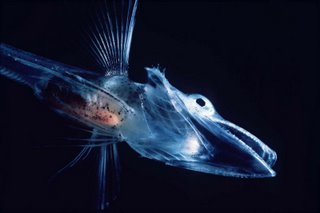
The 16 species of Antarctic icefish have no haemoglobin in their blood at all. This is unique among vertebrates (animals with backbones), and since haemoglobin is what gives red blood cells their colour, these fish are a ghostly white.
They live around Bouvet Island in the Antarctic Ocean. A tiny, desolate, and ice-covered hunk of volcanic rock which, through continental drift, slowly moved south millions of years ago into colder waters.
Over a 55 million year period these fish adapted to the colder waters by firstly decreasing the proportion of red blood cells and then doing away with them all together.
This is because red blood cells thicken the blood which is not helpful in cold water and producing specialised blood pigments requires more energy.
Compared to other fish they have higher blood volumes and larger hearts which helps them transport oxygen without the need for blood pigments.
Their gills have also grown larger over time and their skin is filled with a mass of capillaries that absorb oxygen directly from the water. They are also unique in that they have no scales.
Icefish skeletons are much lighter than most fish because they have a low mineral density. In humans this may be a precursor to osteoporosis so scientists study icefish to learn more about osteoporosis in us.
The first icefish was discovered in 1927 by zoologist Ditlef Rustad, who pulled up a strange, pale fish during an Antarctic expedition.
They are amazing animals that are currently facing two threats – overfishing and climate change. Currently their stocks appear to be sustainable but if the water warms up there’s a good chance they will become extinct.

